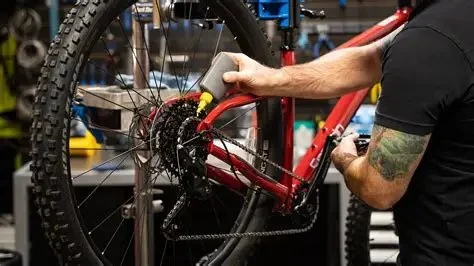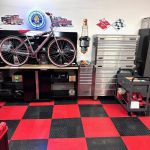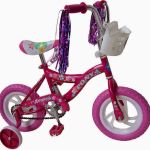
- routine-bike-cleaning
- chain-and-drivetrain-care
- brake-system-checks
- tire-and-wheel-maintenance
- gear-and-derailleur-tuning
- frame-and-suspension-inspection
- seasonal-and-long-term-storage-tips
- real-rider-experiences-and-pro-tips
1. Routine Bike Cleaning
1.1 Why Cleanliness Matters
A clean bike doesn’t just look good — it performs better and lasts longer. Dirt and grime can wear down components, reduce efficiency, and even cause mechanical failures over time. Regular cleaning is the first step in learning how to maintain your bike like a pro.
1.2 The Right Cleaning Process
Start by rinsing your bike with low-pressure water. Use a bike-specific cleaner and soft brushes to scrub the frame, chainrings, and cassette. Avoid high-pressure hoses, as they can push dirt into bearings and seals. Wipe the bike dry with a clean towel, and inspect for any damage while you're at it.
2. Chain and Drivetrain Care
2.1 Lubrication Essentials
Your chain is the heart of your drivetrain. Keeping it properly lubricated reduces wear and enhances performance. After each ride in wet or dusty conditions, wipe it clean and apply fresh lubricant suited for the environment (wet or dry lube).
2.2 Drivetrain Degreasing
Every few weeks, use a chain cleaning tool or remove the chain entirely for deep degreasing. Dirty cassettes and derailleurs can cause shifting problems and premature wear. Riders can find top-rated maintenance kits at Cycling Guider to simplify the task.
3. Brake System Checks
3.1 Rim vs. Disc Brakes
Whether your bike uses rim or disc brakes, both require attention. Rim brake pads should be inspected for even wear and replaced when grooves fade. Disc brakes need occasional rotor cleaning and brake pad inspection.
3.2 Safety and Responsiveness
Brake levers should feel firm, not spongy. If they feel loose, you may need to tighten cables or bleed hydraulic lines. A real-world example: cyclist Julia discovered her brakes dragging during a descent in the Alps — a minor pad misalignment that could’ve become a major hazard if ignored.
4. Tire and Wheel Maintenance
4.1 Tire Pressure and Wear
Check tire pressure before every ride. Under-inflation increases rolling resistance and puncture risk, while over-inflation can reduce traction. Also, look for embedded glass or cracks that suggest it’s time to replace your rubber.
4.2 Truing and Spoke Tension
Wobbly wheels? That could be a sign your wheel needs truing — the process of adjusting spoke tension. Unaddressed, it may lead to broken spokes or a bent rim. If unsure, visit a shop or check out tool kits available from Cycling Guider.
5. Gear and Derailleur Tuning
5.1 Smooth Shifting Mechanics
Does your chain hesitate or jump gears? Your derailleur likely needs indexing. Small tweaks to the barrel adjuster can realign cable tension, offering crisp, reliable shifting. It’s a small detail with a big impact on ride quality.
5.2 Cable and Housing Inspection
Friction in old cables can delay shifting. Replace frayed cables and inspect housing for cracks or compression. Smooth shifting starts at the source.
6. Frame and Suspension Inspection
6.1 Structural Integrity
Run your fingers along your frame after big rides or crashes. Look for cracks, paint chips, or unusual creaks. These can be early warnings of structural issues.
6.2 Suspension Care
If you’re riding a bike with suspension, such as an MTB, keep fork and shock seals clean and regularly check for oil leaks. Depending on usage, a service every 50-100 hours of riding is standard practice.
7. Seasonal and Long-Term Storage Tips
7.1 Preparing for Storage
If you’re hanging up your bike for a season, clean it thoroughly, inflate the tires, and lubricate the chain to prevent rust. Store it in a cool, dry place away from direct sunlight.
7.2 Winterizing Your Ride
For winter conditions, consider swapping to studded tires and using wet lube. Salt from roads can corrode your drivetrain fast — rinse your bike after every snowy ride.
8. Real Rider Experiences and Pro Tips
8.1 Lessons from the Road
In a recent bikepacking series shared online, endurance cyclist Mateo emphasized checking bolts before every trip. He learned the hard way when his handlebar stem loosened during a rocky descent — a simple maintenance miss that almost caused a crash.
8.2 Tools of the Trade
Pros don’t use fancy gear for the sake of it — they rely on the right tools. Investing in a solid bike stand, torque wrench, and a digital tire gauge makes home maintenance far easier. Cycling Guider features curated maintenance tools that both beginners and experienced riders trust.
Learning how to maintain your bike like a pro isn’t about perfection — it’s about attention, consistency, and knowing what to look for. With the right habits and tools, your bike will thank you every ride.







 Billet BMX5.0 (2 reviews)
Billet BMX5.0 (2 reviews) Far East Children Bicycle Factory1.0 (1 reviews)
Far East Children Bicycle Factory1.0 (1 reviews) Archer Motorsports, Inc.4.0 (8 reviews)
Archer Motorsports, Inc.4.0 (8 reviews) YEP Bike Works4.0 (55 reviews)
YEP Bike Works4.0 (55 reviews) Gorham Bike & Ski4.0 (498 reviews)
Gorham Bike & Ski4.0 (498 reviews) Alchemy Bikes4.0 (37 reviews)
Alchemy Bikes4.0 (37 reviews) How to Teach Kids to Ride a Bike: A Step-by-Step Guide for Parents
How to Teach Kids to Ride a Bike: A Step-by-Step Guide for Parents Tips for Riding on Busy City Streets: Smart Strategies for Urban Cyclists
Tips for Riding on Busy City Streets: Smart Strategies for Urban Cyclists Best US National Parks for Mountain Biking: Ride Epic Trails Across America
Best US National Parks for Mountain Biking: Ride Epic Trails Across America Best Aero Helmets for Time Trials and Racing
Best Aero Helmets for Time Trials and Racing How to Clean and Lubricate Your Bike Chain Like a Pro
How to Clean and Lubricate Your Bike Chain Like a Pro 10 Must-Have Items for Long-Distance Cycling Trips
10 Must-Have Items for Long-Distance Cycling Trips